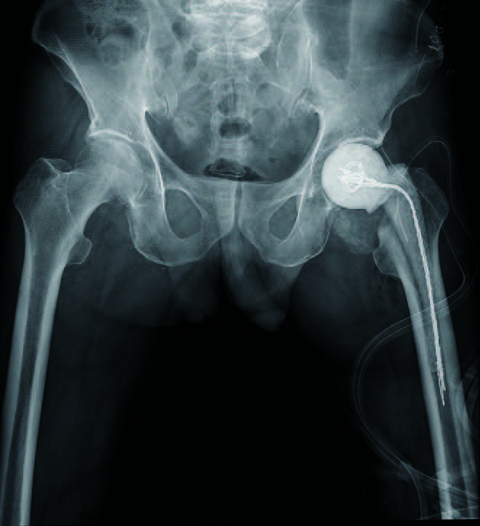Hip Pelvis.
2014 Sep;26(3):189-193. 10.5371/hp.2014.26.3.189.
Rapid Destruction of the Hip Joint Accompanied by an Enlarged Iliopsoas Bursa in a Healthy Man
- Affiliations
-
- 1Department of Orthopedic Surgery, Gwangju Veterans Hospital, Gwangju, Korea. chm1228@hanmail.net
- KMID: 2054184
- DOI: http://doi.org/10.5371/hp.2014.26.3.189
Abstract
- Association between enlarged iliopsoas bursa and hip lesions such as osteoarthritis of the hip or femoral head necrosis is infrequently seen. Enlarged iliopsoas bursa with a rapidly destructive arthropathy is claimed to be seen only in patients with rheumatoid arthritis. In this paper, we report a patient with a rapidly destructive arthropathy accompanied by an enlarged iliopsoas bursa that has been misdiagnosed as an infection.
Figure
Reference
-
1. Bock GW, Garcia A, Weisman MH, Major PA, Lyttle D, Haghighi P, Greenway GD, Resnick D. Rapidly destructive hip disease:clinical and imaging abnormalities. Radiology. 1993; 186:461–466.
Article2. Matsumoto T, Juji T, Mori T. Enlarged psoas muscle and iliopsas bursaitis associated with a rapidly destructive hip in a patient with rheumatoid arthritis. Mod Rheumatol. 2006; 16:52–54.
Article3. Batra S, Batra M, McMurtrie A, Sinha A. Rapidly destructive osteoarthritis of the hip joint: a case series. J Orthop Surg Res. 2008; 3:3.
Article4. Ronningen H, Langeland N. Indomethacin treatmen in osteoarthritis of the hip joint. Acta Orthop Scand. 1979; 50:169–174.5. Boutry N, Paul C, Leroy X, Fredoux D, Migaud H, Cotton A. Rapidly destructive osteoarthritis of the hip:MR imaging findings. AJR Am J Roentgenol. 2002; 179:657–663.6. Lee KH, Sung MS, Kim HM, Kim YS, Choi MG, Jeong CH, Yoon SJ. MR imaging of osteonecrosis of the femoral head with rapidly destructive coxarhtrosis. J Korean Orthop Assoc. 2003; 38:105–110.
Article7. Toohey AK, LaSalle TL, Martinez S, Polisson RP. Iliopsoas bursitis: Clinical features, radiographic findings and disease associations. Semin Arthritis Rheum. 1990; 20:41–47.
Article8. Binek R, Levinsohn EM. Enlarged iliopsoas bursa. An unusual cause of thigh and hip pain. Clin Orthop. 1987; 224:158–163.9. Johnston CA, Wiley JP, Lindsay DM. Iliopsoas bursitis and tendinitis. Sports Med. 1998; 25:271–283.
Article10. Menkes CJ, Simon F, Delreiu F, Forest M, Delbarre F. Destructive arthropathy in chondrocalcinosis articularis. Arthritis Rheum. 1976; 19:329–348.
Article
- Full Text Links
- Actions
-
Cited
- CITED
-
- Close
- Share
- Similar articles
-
- An Enlarged Iliopsoas Bursa Associated with Osteonecrosis of the Femoral Head: A Case Report
- Femoral Nerve Palsy caused by Iliopsoas Bursitis Associated with Osteonecrosis of the Femoral Head : A Case Report
- Obturator Externus Bursitis: Cases report
- Septic Hip Arthritis with Iliopsoas Abscess Detected after Spine Operation: A Case Report
- Femoral Vessels Compression Caused by Iliopsoas Bursitis





